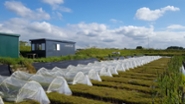
More realistic research needed on substances that enter the environment
Chemical substances and nanomaterials are processed on a massive scale in diverse products, while their risks have not been properly assessed. Time and again synthesised substances have been shown to pollute the environment more than lab tests predicted. This is the warning given by Professor of Ecotoxicology Martina Vijver from Leiden University in her inaugural lecture on 16 November.
Laboratory tests are inadequate, according to Vijver, because they do not imitate a complete ecosystem. In her inaugural lecture she will discuss in greater detail two examples of substances where more realistic research is needed: agricultural toxins and nanoparticles. ‘But the same can be said for many other groups of substances, such as antibiotics, plasticizers and GenX.’
Aquatic life hardest hit
Her research on neonicotinoids, the world's best-selling insecticides, shows that aquatic life in the Netherlands has been harder hit than expected.'Toxicity protocols that are intended to protect the environment are based on lab tests that generally estimate the effects on an ecosystem based on the sum of the effects on a handful of species. They are also exposed to the toxins under constant lab conditions. This is a gross oversimplification of the complexity of an ecosystem.' Vijver also believes that lab tests do not take adequate account of the fact that chemical substances and organisms cross the boundaries of water, soil and air.

Living lab
Vijver is one of the initiators of the Living Lab: in 2016, 38 natural ditches were dug out on the Leiden Bio Science Park. The ditches connect directly with open water, so it is possible to test realistically what the actual effects are of agricultural toxins and other potentially toxic substances. The results are disturbing. Water fleas proved to be 2,500 times more sensitive to the effects in the ditches where agricultural toxins were administered - they died much faster - than in an ordinary lab where the conditions are more constant. And there were more unexpected consequences. The diversity of species on the banks of the ditches decreased because there was less food in and around them.

Nanoparticles in the environment
In her inaugural lecture, Vijiver calls for more thorough research on the possible risks of nanomaterials. These minuscule particles of a substance - between 1 and 100 nanometres - turn up in the most diverse products such as computers, cosmetics and textiles. These substances are not yet flooding the world on a massive scale but that's only because nanotechnology is still new. Vijver's research group in Leiden showed that nanoparticles bigger than 50 nanometres gather mainly in the intestinal system of organisms that are exposed to them, while smaller nanoparticles can be found anywhere in the body.
Longer term effects
The longer term impact of these particles on the ecosystem is not yet known. This is what Vijver and her colleagues and PhD candidates will be researching in the coming years. She comments, 'It's not often that we can foresee all the consequences of our human activities. Still, before we put technological developments into practice on a large scale, we have to make more realistic risk assesments for newly developed substances.'
